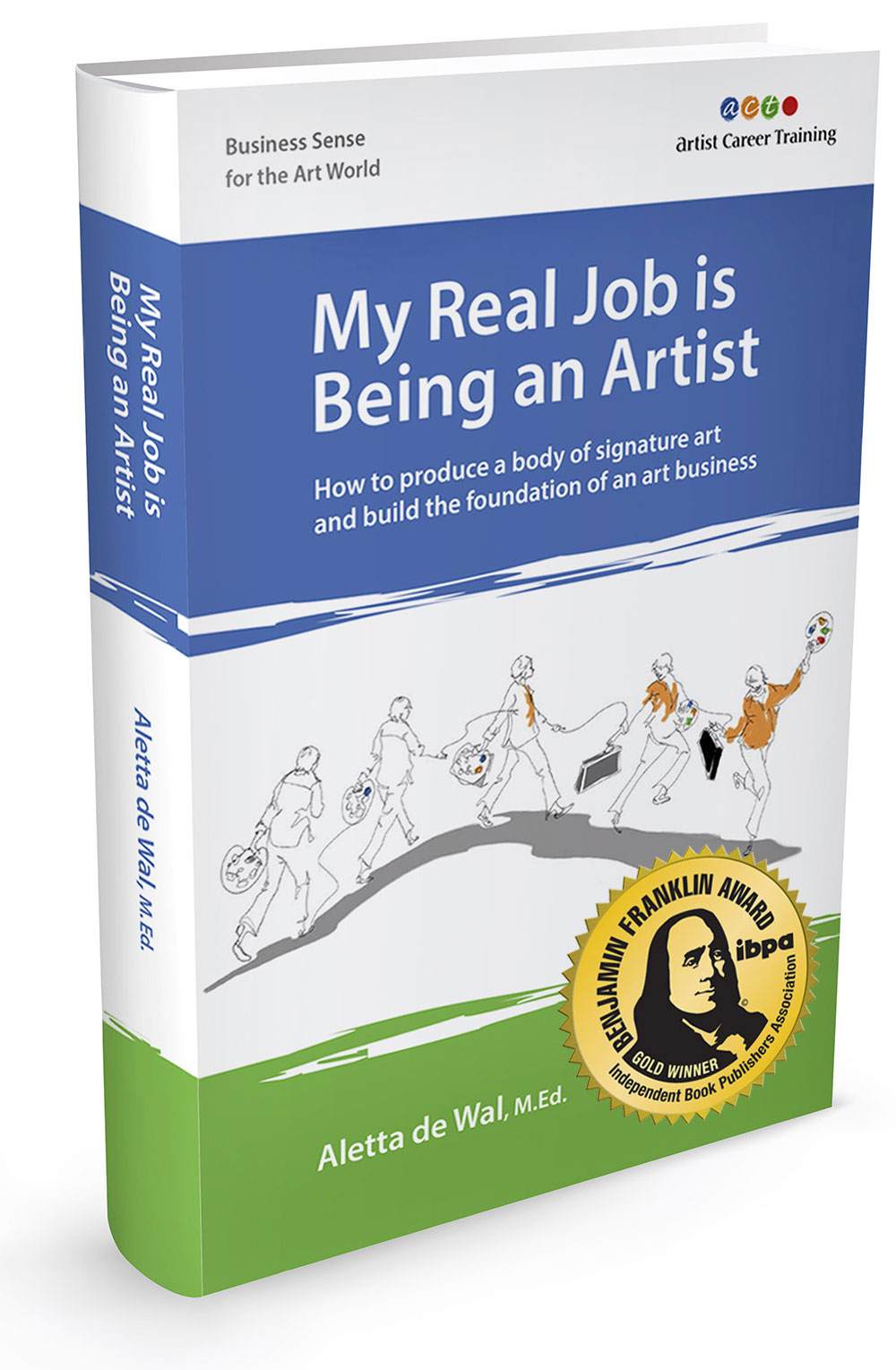My primary goal in these interviews is to inspire you with stories of people who make a living making art and who consider it a real job." Your art and your career may be on a different path, but there is always something to learn from the experience of your colleagues.
Scroll down for the list of other artists who have been featured.
John Seed, Art-Explainer and Storyteller
__________________________________________
 |
John Seed is a professor of art and art history at Mt. San Jacinto College in Southern California. Winner of a 2002 Society of Professional Journalists award in art and entertainment writing, he has written about art and artists for Harvard Magazine, Maui No Ka Oi, Honolulu, Christie's Hong Hong and Stanford. He is also a co-editor for OpenMuseum.org and he writes for The Huffington Post.
"Looking back, I had no idea I was an artist - I was just a very busy, hands on kid. I used to draw a cartoon for my dad when he came home from work. When I was growing up, my father added a workshop behind our garage. Through the years I built model airplanes, worked on bicycles and put a Volkswagen Baja Bug together from spare parts. I also drew quite a bit, and performed puppet shows at children's birthday parties with two friends. It is fair to say that I was intensely creative.
"When I got to college, I couldn't keep my mind on academics without a creative outlet, so I took a painting class and I was hooked. My second art class was a monotype course taught by painter and print maker Nathan Oliveira, and that class and his generosity changed my life. Nathan, who I looked up to tremendously, became my mentor and I decided to major in art with the goal of becoming an art professor.
 |
|
©Seed & Oliveira Stanford Graduation, 1979 |
"To this day I say half-jokingly that I like the Buddhist idea of teachers coming from a 'lineage' and that makes me an artist/teacher in the Oliveira lineage. Like my mentor, I place a high value on art that expresses universal emotions.
"I did also write one art review in college - it was a review of a Richard Diebenkorn show that was printed by the Stanford Daily - but I didn't take up writing about art again until about ten years ago. By the way, I found that Diebenkorn review in a scrapbook a few years ago, and it was embarrassingly bad."
"I started as a representational painter influenced by the painters of the Bay area where I initially went to school. I then worked for an art collector. Later I worked for the notorious art dealer Larry Gagosian when he was new. I also worked at M.O.C.A. at that time.
"Over 25 years of teaching, there has been a lot of processing and explaining myself and other artists. Behind every work of art is a man or woman with a story to tell. I am not an art critic, but rather an explainer. I try to sketch the human being and the emotional forces behind the works of art, and let my readers then see if they can connect to the material on their own terms.
"I have very broad taste, but in the past year I have mainly written about representational paintings because I feel that they have been short-changed in recent criticism. I have an underdog affection for it. I veer away from the stories that have been told.
 |
|
©Matt Couper |
"I have taught art history and art appreciation to community college students for 25 years. I started at Art Center College of Design in Pasadena as well at Mt. San Jacinto Community College. I've taught studio and art history.
 |
|
©Seed teaching Studio |
"Believe me, I am not about 'dumbing down' but at the same time I am very wary of art criticism that is pretentious, convoluted and doctrinaire. I have a low tolerance for intellectual snobbery."
"The way I see it, a critic is someone deeply knowledgeable who offers value judgments. A critic who I very much respect is Robert Pincus, formerly of the San Diego Union Tribune. A few months ago I had the unhappy job of blogging about his layoff.
"At a community forum in La Jolla following the Pincus layoff, the moderator told us that there are now only 6 full time visual arts critics writing for American newspapers and magazines. That was a shock. As a culture we need our critics and our professional journalists.
"In a sense, it is ironic that an unpaid blogger like myself had to blog about the Pincus layoff. The fact that there are bloggers like myself who write for the exposure -- and out of vanity -- replacing paid experts with long track records is unsettling. I will say, there are some fantastic bloggers appearing, and I think that the blogs done by James Elkins for the Huffington Post are a revelation.
"I read Peter Schjeldahl, Robert Hughes, Lance Esplund, Jed Perl, Roberta Smith and Jerry Saltz whenever I can, and this keeps me humble. They are the critics.
"So, I try to keep it real, and I label myself as an 'Art Writer' or 'Art Blogger' and avoid making critical statements. What I do instead is try to tell great stories, or write about art and artists that strike me personally as being interesting. In that one sense I guess I am a critic, because I do choose who and what to write about, and I have been saying 'no' more as more contacts come my way.
"I like great stories, and sometimes the stories overshadow the art. The first artist I wrote about, Arman Manookian, was a survivor of the Armenian genocide who took his own life in Hawaii at the age of 27. His life story is extremely compelling. Recently I blogged about Romualdo Locatelli, an Italian who disappeared outside of Manila during the war.
"So, there you have it. I am a story-teller, and an art explainer. I have learned from teaching art appreciation that people have innate taste that rarely changes, and I respect that. I try to tell them more -- and to do it respectfully and thoughtfully -- and then they can apply their taste."
"The Huffington Post is wonderful, because they allow me to write about who and what I want to on a whim. I read exhibition reviews, look at artist's pages on Face Book, network with friends and keep my eyes open. When I find an artist whose work speaks to me, I contact them and get to work writing.
"Recently I told an artist that I didn't want to write about her work, and the reason I gave her was very simple. 'I don't connect with your work' is what I told her, and it was true. She in turn was very gracious about it.
"I think the biggest mistake that artists make is excessive self-promotion. I like artists who are putting their energy into their art, not into blowing their own horns. My advice to artists is 'Make some terrific work, and you will be written about and taken seriously.'"
"When I worked as a studio assistant with Basquiat, he skyrocketed and the hype really affected him badly. That soured me and it made me think about how I wanted to be represented. As I started getting noticed, a collector took about eight of us to lunch. He told me that he wanted to buy me the right clothes, take me to all the right openings and introduce me to his wealthy friends. In many ways that man was right, but I rebelled because I was idealistic and I wanted to be ready and not just know the right people. I went back to the studio after that. I am a big believer in making the very best work that you can and let the collector, gallery dealer and writers want to know you.
"Aletta, when you tell me that many artists you know invest half their time in marketing, that seems out of balance to me. The best artists I know are the ones with strong studio work ethics. I think it shows in what they produce. I wonder if in the age of the Internet, artists aren't getting distracted tinkering with their personal websites.
"In the late 90's I had the idea of forming an art group on eBay by putting a common, unique search term in title of every auction by artists in the group. All of us put 'ebsq' into our titles, and before long it became the 'EBSQ Artists Group' with a website and a blog that I edited. While I was still leading the group, we convinced eBay to open a 'Self-Representing Artists' category, and it was a very exciting time.
"Eventually, the group was taken over by a very clever artist -- Amie Gillingham -- and she and her husband have done amazing things with the group, and it is still going strong.
"Why do I bring this up? Well, being involved with EBSQ really taught me a few things. Anyone can sell on eBay, anyone can have a personal artist website, and anyone can say 'I am an artist.' Generally speaking, those are all good things. I certainly remember how hard it was to find a dealer to represent me when I was starting out as an artist in the early 80's.
"What I found with EBSQ is that yes, everyone got to be an artist, but the members still faced a daunting set of problems. To achieve respectable prices and to move forward and upward, they still generally yearned for the chance to find bricks and mortar representation.
"If an artist is really ambitious, they have to ask themselves 'What is going to make me stand out?' The answer is always the same: great work. What good is all the networking, all the website design and all the Facebooking if your work simply isn't superb? The Internet hasn't changed everything. To have a real career as an artist you still need to find your way into the very intense hierarchy of the art world, and critics, curators and collectors are still the gatekeepers to that world. They are going to find you if your work is outstanding.
"When Willem de Kooning won a $3,000 prize for his painting 'Excavation' in 1950, it took days for a messenger to track him down and deliver the check. Why? De Kooning was too absorbed in painting to come to the door. A nice fable, I know...
"What is excessive self-promotion? I think that happens when an artist becomes cynical and says 'Marketing is more important than my art.' That is the exact moment when art becomes a job and not a passion. Yes, Mark Kostabi, Thomas Kinkade and Wyland have made a lot of money, but their genius is in marketing, not in art. Excessive self-promotion can involve making outlandish claims about one's work, flattering the 'right people,' and making work with a flavor-of the-month mentality.
"If my views seem a bit lofty, I am going to gently defend myself by saying that one of my goals as an arts blogger is to write about deserving artists who haven't yet gotten the attention they deserve. When I recently wrote about Rod Penner -- an amazing Hyperrealist -- his dealer Ivan Karp sent me a very warm thank you e-mail, and noted that it was the first feature article written about Rod and his work in the past ten years. Of course, he didn't need me to write about Rod. His shows have been quietly selling out for a long time because of the quality of what he does."
"My great fortune is that teaching pays my bills. So, blogging about art and artists is my hobby, and my social life. I have three girls - 4, 7 and 12 - so I write before they get up, at lunch and after they go to bed. I also make calls to artists on my lunch break or after class. When I am jogging, or stuck in traffic my mind is turning over, and I get ideas about what I am going to write."
"Eight years ago, I had a terrible year: I took chemotherapy for testicular cancer and went through a divorce at the same time. After I finished chemo I learned that an article I had written for Honolulu Magazine about Arman Manookian had won a Society of Professional Journalist's Award. It blew me away, as it was the first article I had ever published in a magazine. That award gave me tremendous confidence.
"Also, two years ago I wrote about Fernando Zobel de Ayala - an artist who I am writing a book about - for Harvard Magazine. My parents still have that on their coffee table."
"Success is doing what you love. When I had cancer I had to confront my mortality, and I realized that if I had my life over again I would want to be a painter and a community college art professor.
"I celebrate my success by trying to give my students the same emotional connection and enthusiasm that I received from Nathan Oliveira."
 |
|
©Seed & Oliveira |
"My biggest obstacle was myself when I was younger. I was lucky as a kid to have everything I needed and I expected a lot.
"My favorite rejection was going into the Fuller Goldein Gallery and giving my name at the counter. The employee went to a row of file cabinets, looked up my name and gave me a copy of my rejection letter. That was a reality check.
"Before I wrote for the Huffington Post I contacted a local newspaper and offered to write art reviews. I got a 'yes' and a first assignment from the editor, and wrote what I thought was a strong review of a group show in our area.
"The editor sent it back with a cute title and bullet points and told me to simplify it and take out my opinions. I told him to take my name off it, tore some hair out, and was fortunate enough to become associated with the Huffington Post a month later.
"I am a big believer in going where you are appreciated, and my editor at the Huffington Post, Kimberly Brooks, has been very supportive of everything I have done. You can see a Powerpoint video for 2010 Blogs here."
"I like and deeply respect artists. Every time I write about an artist I make a new friend, and that is priceless. I am ready to make enemies if I need to, but it hasn't happened yet."
"Besides Nathan Oliveira, I had the good fortune to meet Robert De Niro Sr. who was a very dedicated painter. He told me 'Don't worry about style, just worry about being good.' That was priceless advice.
"Every good artist should be told 'Some day you're going to have a storage problem. Get your work out there.'"
"I have worked for dealers, including Larry Gagosian who I worked for in the early 80's. Dealers also represented me when I was painting. Now I consult and do research for a private dealer. That said, I like what Laddie John Dill, who has been in the art world for 40 years, once told me: 'The art world was nuts when I was getting started, and it is still nuts.'
"I also knew and worked as a studio assistant for Jean-Michel Basquiat, and that gave me a kind of front row view to an unfolding tragedy. Jean was a genius, but I wouldn't have wanted his life for a second. Knowing him was a kind of a good influence in a negative way, as the swamp of drugs, hangers-on and sharks that surrounded him were a cautionary tale. Fame is for the fearless.
"Hang on to your integrity, and don't let materialistic madness get to you. If you learn to be yourself, despite all the forces tugging at you, you will be OK as a person, and also will prosper.
"The Internet has created a lot of opportunities for artists to get their work out there. We still have some of the same problems to face. How do you get greater recognition, eminence and noticed over a long time?
"We are all distracted these days and that makes studio time even more precious."
"Be ready to embrace harsh criticism from others but remember that you can take it or leave it. When people are tough on you, they may give you the very best lessons. Be a little less thin-skinned. If you really think the criticism is wrong - drop it.
"Be all about your art. Let dealers, curators, and writers come to you. I will say, I think Face Book is great, and making a network of art world connections there works well.
"Be sure you deserve what comes your way. When you feel that you are mature, and that your work really speaks for you, step forward, be discovered, and enjoy it. If you are seventy-five when it happens there is nothing wrong with that."
"It is wonderful that these resources are available. When I was showing paintings I was pretty much on my own and I had to 'wing it' figuring how to work with dealers and collectors.
"You can help artists compartmentalize, take a little of the pressure off them and help them navigate the art world. It helps to have a coach like you to help them deal with the hierarchical art world. Artists can look at your resources, be open to new ideas and benefit from your experience."











